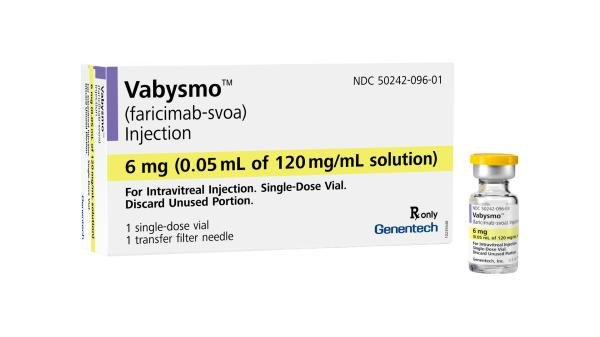Faricimab ophthalmic
Generic name: faricimab ophthalmic [ far-IK-i-mab ]
Brand names: Vabysmo, Vabysmo Prefilled Syringe
Dosage form: intravitreal solution (svoa 6 mg/0.05 mL)
Drug class: Anti-angiogenic ophthalmic agents
What is faricimab ophthalmic?
Faricimab ophthalmic (for the eyes) is used in adults to treat an eye condition called neovascular age-related macular degeneration.
Faricimab ophthalmic is also used in adults to treat swelling inside your eye caused by diabetes or a blockage in the blood vessels of the eye.
Faricimab ophthalmic may also be used for purposes not listed in this medication guide.
Faricimab ophthalmic side effects
Get emergency medical help if you have signs of an allergic reaction: hives, difficult breathing, swelling of your face, lips, tongue, or throat.
Faricimab ophthalmic may cause serious side effects. Call your doctor at once if you have:
-
signs of eye infection--swelling, severe discomfort, crusting or drainage;
-
severe eye redness or pain;
-
eyes being more sensitive to light; or
-
changes in your vision.
Common side effects of faricimab ophthalmic may include:
-
blurred vision, eye pain or redness, seeing halos around lights; o
-
bleeding in the white part of the eye.
This is not a complete list of side effects and others may occur. Call your doctor for medical advice about side effects. You may report side effects to FDA at 1-800-FDA-1088.
Related/similar drugs
Warnings
You should not receive faricimab ophthalmic if you have swelling or infection in or around your eye.
Before taking this medicine
You should not receive faricimab ophthalmic if you are allergic to it, or if you have:
-
swelling, redness, pain inside or around your eyes; or
-
any type of infection in or around your eyes.
Tell your doctor if you have ever had:
-
a heart attack or stroke; or
-
glaucoma or any other condition that increases pressure inside your eyes.
It is not known if faricimab ophthalmic will harm an unborn baby. Use effective birth control while using faricimab ophthalmic and for at least 3 months after your last dose. Tell your doctor if you are pregnant or plan to become pregnant.
Ask a doctor if it is safe to breastfeed while using faricimab ophthalmic.
How should I receive faricimab ophthalmic?
Your doctor will determine your treatment schedule and how long you should use this medicine.
Faricimab ophthalmic is injected in your eye. A healthcare provider will give you this injection.
After receiving this medicine, you will be watched closely to make sure you do not have serious side effects.
You will need frequent vision exams before and after receiving this medicine.
What happens if I miss a dose?
Call your doctor for instructions if you miss an appointment for your faricimab ophthalmic injection.
What happens if I overdose?
In a medical setting an overdose would be treated quickly.
What should I avoid while receiving faricimab ophthalmic?
faricimab ophthalmic may cause blurred vision and may impair your reactions. Avoid driving or hazardous activity until you know how this medicine will affect you.
What other drugs will affect faricimab ophthalmic?
Medicine used in the eyes is not likely to be affected by other drugs you use. But many drugs can interact. Tell your doctor about all your current medicines, including prescription and over-the-counter medicines, vitamins, and herbal products.
Faricimab ophthalmic Biosimilars
Biosimilar and interchangeable products are biological products that are highly similar to and have no clinically meaningful differences from the reference product.
Reference products
These are biological products that have already been approved by the FDA, against which biosimilar products are compared. There is 1 for faricimab ophthalmic.
Vabysmo (faricimab-svoa) - Genentech, Inc.
| Formulation type | Strength |
|---|---|
| Pre-Filled Syringe | 6 mg/0.05 mL (120 mg/mL) |
| Single-Dose Vial | 6 mg/0.05 mL (120 mg/mL) |
View Vabysmo information in detail.
More about faricimab ophthalmic
- Check interactions
- Compare alternatives
- Reviews (39)
- Side effects
- Dosage information
- During pregnancy
- Drug class: anti-angiogenic ophthalmic agents
- Breastfeeding
- En español
Patient resources
Other brands
Professional resources
Other brands
Related treatment guides
Further information
Remember, keep this and all other medicines out of the reach of children, never share your medicines with others, and use this medication only for the indication prescribed.
Always consult your healthcare provider to ensure the information displayed on this page applies to your personal circumstances.
Copyright 1996-2025 Cerner Multum, Inc. Version: 1.01.

